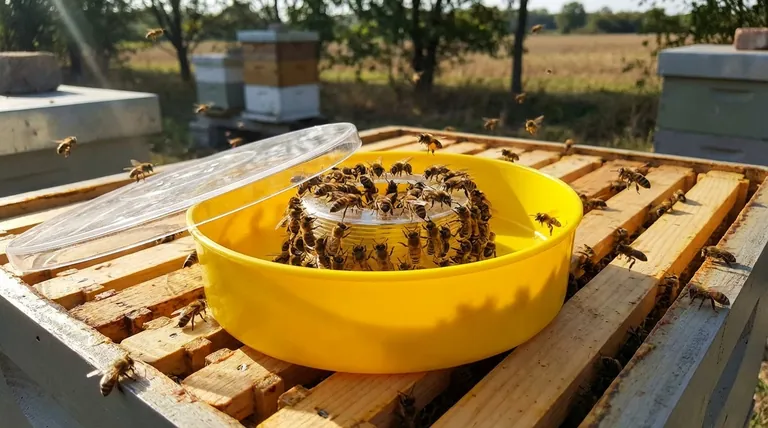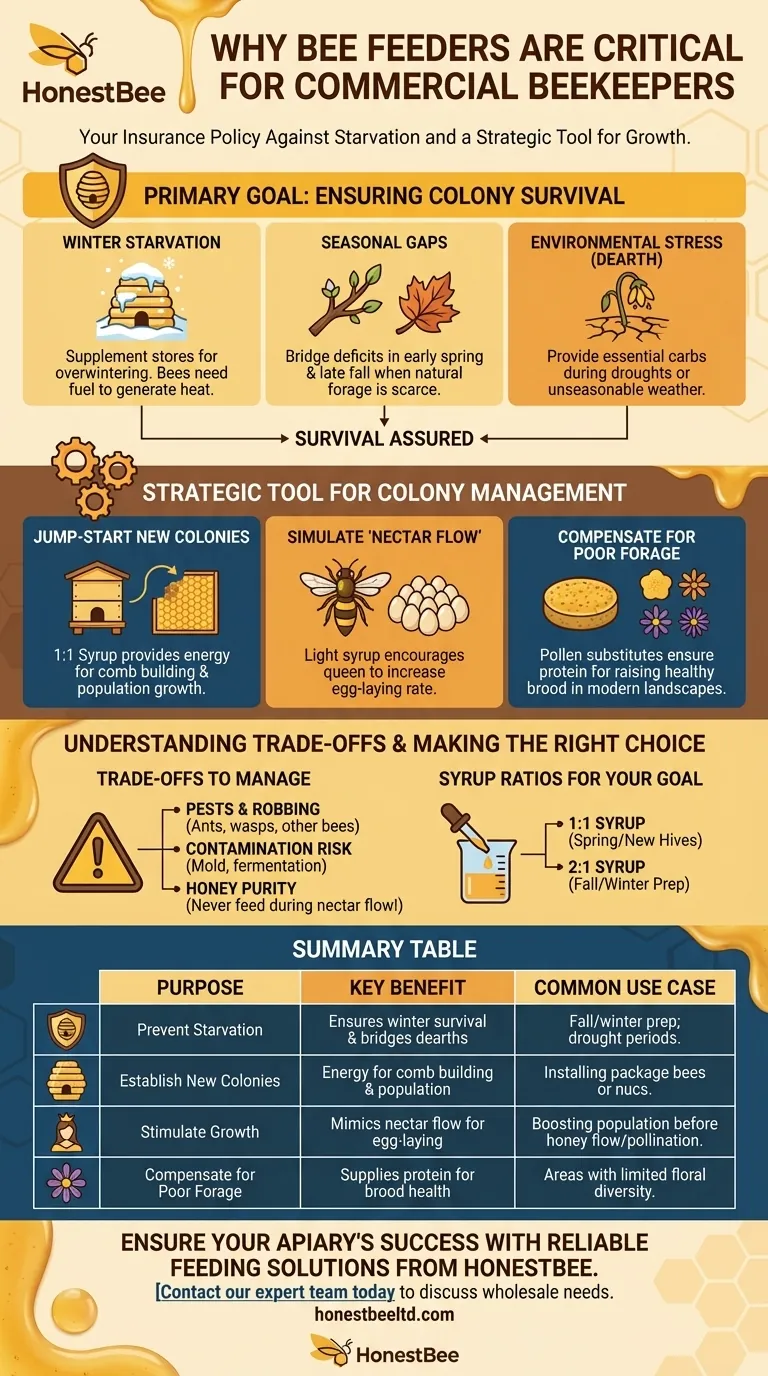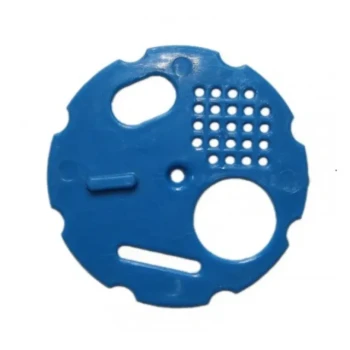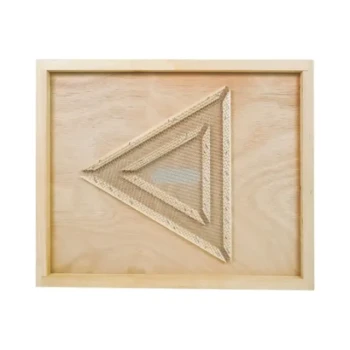At its core, a bee feeder is an insurance policy against starvation. Beekeepers use feeders to provide supplemental food, typically sugar syrup or pollen substitutes, when natural nectar and pollen resources are scarce. This intervention is most critical when establishing a new colony and to ensure the hive has enough food to survive the cold winter months.
A bee feeder is more than just a food dish; it is a strategic tool for proactive hive management. Beekeepers use it not only to prevent starvation but also to strengthen a colony and stimulate its growth in response to environmental challenges or specific beekeeping goals.

The Primary Goal: Ensuring Colony Survival
A honey bee colony's ability to survive is directly tied to its access to food. When natural resources dwindle, a feeder becomes the most important tool a beekeeper has.
Preventing Starvation in Winter
Bees do not hibernate. Instead, they form a cluster inside the hive to generate heat, and they consume their stored honey as fuel to survive the cold. If a colony fails to store enough honey before winter, it will starve. A feeder allows a beekeeper to supplement these stores, ensuring the bees have enough energy to make it to spring.
Navigating Critical Seasonal Gaps
The periods of early spring and late fall are particularly vulnerable times. In early spring, the queen begins laying eggs to build up the summer workforce, but natural flowers may not be blooming yet. In late fall, the nectar flow has often stopped, but the bees still need to top off their winter pantry. Feeding during these gaps bridges the nutritional deficit.
Mitigating Environmental Stress
Droughts, extended periods of rain, or unseasonable cold can create a "nectar dearth"—a time when flowering plants produce little to no nectar. During these periods, a feeder provides the essential carbohydrates the bees need to maintain the colony's strength and continue raising young.
A Tool for Strategic Colony Management
Beyond simple survival, feeding is used to influence a colony's development and compensate for deficiencies in the modern landscape.
Jump-Starting a New Colony
When a beekeeper installs a new package of bees or a small nucleus hive, the colony has a monumental task: it must build wax comb, the queen must start laying, and workers must raise the first generation of brood. Providing a steady supply of sugar syrup gives them the immediate energy required to establish themselves quickly and efficiently.
Simulating a "Nectar Flow"
A beekeeper can use a feeder to mimic an abundance of natural resources. This simulated "nectar flow" encourages the queen to increase her egg-laying rate. This technique is often used to rapidly boost a colony's population ahead of the main honey season or for pollination contracts.
Compensating for Poor Forage
Modern agricultural and urban landscapes often lack the diverse, consistent floral sources that bees require for optimal health. A lack of varied pollen can lead to nutritional deficiencies. Beekeepers use feeders to provide pollen substitutes, ensuring the bees receive the protein and fats necessary to raise healthy brood.
Understanding the Trade-offs
While essential, using bee feeders requires careful management to avoid creating new problems for the hive.
The Risk of Attracting Pests and Robbers
Open feeders or spilled syrup can attract ants, wasps, and even bees from neighboring hives. This can lead to "robbing," where stronger colonies attack and steal the resources from a weaker one, often destroying it in the process.
Potential for Contamination
Feeders must be kept scrupulously clean. Warm sugar syrup is an ideal medium for mold and fermentation, which can make bees sick. An improperly maintained feeder can do more harm than good.
Impact on Honey Purity
Responsible beekeepers never feed their bees sugar syrup while they are collecting nectar to produce honey for human consumption. Any honey supers (the boxes where surplus honey is stored) must be removed during feeding to ensure the final product is pure honey, not stored sugar syrup.
Making the Right Choice for Your Goal
Deciding when and what to feed is a core skill in beekeeping. It depends entirely on the condition of your colony and your specific objective.
- If your primary focus is establishing a new hive: Provide a consistent 1:1 sugar-to-water syrup to give them the energy needed to build comb and raise their population.
- If your primary focus is preparing for winter: Feed a thick 2:1 sugar-to-water syrup in the fall to help the bees quickly build up their winter food stores.
- If your primary focus is overcoming a nectar dearth: Offer supplemental feed to maintain the colony's strength and prevent a decline in brood rearing.
- If your primary focus is stimulating growth: Use light syrup feeding to encourage the queen to lay more eggs, but only when you have a specific goal, like preparing for pollination.
Ultimately, using a bee feeder is a fundamental act of responsible stewardship, ensuring your bees not only survive but have the chance to thrive.
Summary Table:
| Purpose of Bee Feeder | Key Benefit | Common Use Case |
|---|---|---|
| Prevent Starvation | Ensures colony survival during winter and nectar dearths. | Fall/winter preparation; drought periods. |
| Establish New Colonies | Provides energy for comb building and population growth. | Installing package bees or nucleus hives. |
| Stimulate Growth | Mimics a nectar flow to encourage queen egg-laying. | Boosting population before honey flow or pollination. |
| Compensate for Poor Forage | Supplies protein via pollen substitutes for brood health. | Areas with limited floral diversity. |
Ensure your apiary's success with reliable feeding solutions from HONESTBEE.
As a commercial beekeeper or distributor, consistent colony health is your bottom line. Proper feeding is fundamental to preventing losses and maximizing productivity. HONESTBEE supplies durable, high-capacity bee feeders and essential beekeeping supplies designed for the demands of wholesale and commercial operations.
Let us help you build a more resilient and profitable beekeeping business. Contact our expert team today to discuss your equipment needs and wholesale pricing.
Visual Guide

Related Products
- HONESTBEE Round Hive Top Bee Feeder for Syrup
- Boardman Entrance Bee Feeder Durable Galvanized Steel and Wood Construction for Beekeeping
- Professional Hive Front Entrance Bee Feeder
- HONESTBEE Entrance Bee Feeder Professional Hive Nutrition Solution for Beekeeping
- Classic Boardman Entrance Bee Feeder Hive Front Feeding Solution
People Also Ask
- What features make top feeders a reliable choice for beekeepers? A Guide to Safe, Efficient Hive Nutrition
- What are the features of top feeders for bees? Maximize Hive Health with Safe, High-Capacity Feeding
- How should syrup for bees be prepared? Master the Ratio for a Thriving Hive
- What types of hive boxes is the round hive top feeder compatible with? Universal Fit for 8 & 10-Frame Langstroth Hives
- What can the round hive top feeder be used for? A Guide to Efficient, Safe Bee Feeding



















